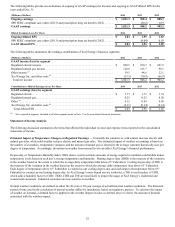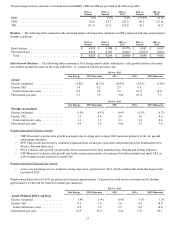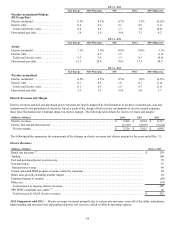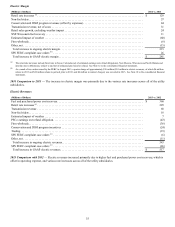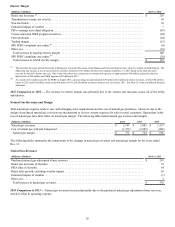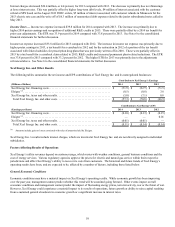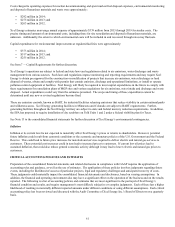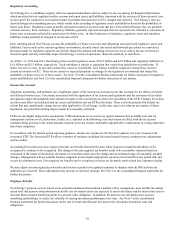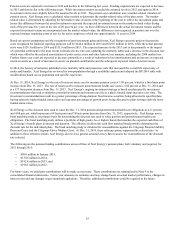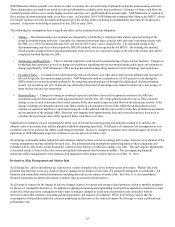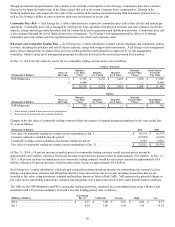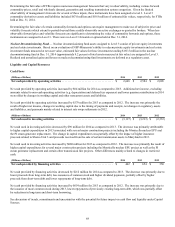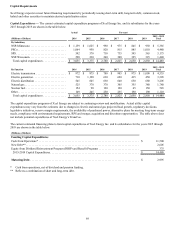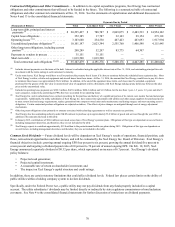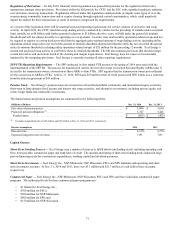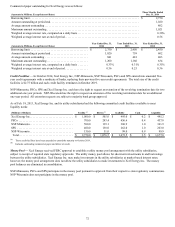Xcel Energy 2014 Annual Report Download - page 80
Download and view the complete annual report
Please find page 80 of the 2014 Xcel Energy annual report below. You can navigate through the pages in the report by either clicking on the pages listed below, or by using the keyword search tool below to find specific information within the annual report.62
Regulatory Accounting
Xcel Energy Inc. is a holding company with rate-regulated subsidiaries that are subject to the accounting for Regulated Operations,
which provides that rate-regulated entities account and report assets and liabilities consistent with the recovery of those incurred costs
in rates and if the competitive environment makes it probable that such rates will be charged and collected. Xcel Energy’s rates are
derived through the ratemaking process, which results in the recording of regulatory assets and liabilities based on the probability of
future cash flows. Regulatory assets generally represent incurred or accrued costs that have been deferred because they are probable
of future recovery from customers. Regulatory liabilities generally represent amounts that are expected to be refunded to customers in
future rates or amounts collected in current rates for future costs. In other businesses or industries, regulatory assets and regulatory
liabilities would generally be charged to net income or OCI.
Each reporting period Xcel Energy assesses the probability of future recoveries and obligations associated with regulatory assets and
liabilities. Factors such as the current regulatory environment, recently issued rate orders and historical precedents are considered.
Decisions made by regulatory agencies can directly impact the amount and timing of cost recovery as well as the rate of return on
invested capital and may materially impact Xcel Energy’s results of operations, financial condition, or cash flows.
As of Dec. 31, 2014 and 2013, Xcel Energy has recorded regulatory assets of $3.2 billion and $2.9 billion and regulatory liabilities of
$1.6 billion and $1.3 billion, respectively. Each subsidiary is subject to regulation that varies from jurisdiction to jurisdiction. If
future recovery of costs, in any such jurisdiction, ceases to be probable, Xcel Energy would be required to charge these assets to
current net income or OCI. There are no current or expected proposals or changes in the regulatory environment that impact the
probability of future recovery of these assets. See Note 15 to the consolidated financial statements for further discussion of regulatory
assets and liabilities and Note 12 to the consolidated financial statements for further discussion of rate matters.
Income Tax Accruals
Judgment, uncertainty, and estimates are a significant aspect of the income tax accrual process that accounts for the effects of current
and deferred income taxes. Uncertainty associated with the application of tax statutes and regulations and the outcomes of tax audits
and appeals require that judgment and estimates be made in the accrual process and in the calculation of the ETR. Changes in tax laws
and rates may affect recorded deferred tax assets and liabilities and our ETR in the future. There exists the potential for federal tax
reform that may significantly change the tax rules applicable to Xcel Energy. At this time, due to the inherent uncertainty of future
legislation, any potential resulting impact cannot be reasonably estimated.
ETRs are also highly impacted by assumptions. ETR calculations are revised every quarter based on best available year-end tax
assumptions (income levels, deductions, credits, etc.); adjusted in the following year after returns are filed, with the tax accrual
estimates being trued-up to the actual amounts claimed on the tax returns; and further adjusted after examinations by taxing authorities
have been completed.
In accordance with the interim period reporting guidance, income tax expense for the first three quarters in a year is based on the
forecasted ETR. The forecasted ETR reflects a number of estimates including forecasted annual income, permanent tax adjustments
and tax credits.
Accounting for income taxes also requires that only tax benefits that meet the more likely than not recognition threshold can be
recognized or continue to be recognized. The change in the unrecognized tax benefits needs to be reasonably estimated based on
evaluation of the nature of uncertainty, the nature of event that could cause the change and an estimated range of reasonably possible
changes. Management will use prudent business judgment to derecognize appropriate amounts of tax benefits at any period end, and
as new developments occur. Unrecognized tax benefits can be recognized as issues are favorably resolved and loss exposures decline.
We may adjust our unrecognized tax benefits and interest accruals to the updated estimates as disputes with the IRS and state tax
authorities are resolved. These adjustments may increase or decrease earnings. See Note 6 to the consolidated financial statements for
further discussion.
Employee Benefits
Xcel Energy’s pension costs are based on an actuarial calculation that includes a number of key assumptions, most notably the annual
return level that pension and postretirement health care investment assets are expected to earn in the future and the interest rate used to
discount future pension benefit payments to a present value obligation. In addition, the pension cost calculation uses an asset-
smoothing methodology to reduce the volatility of varying investment performance over time. See Note 9 to the consolidated
financial statements for further discussion on the rate of return and discount rate used in the calculation of pension costs and
obligations.


